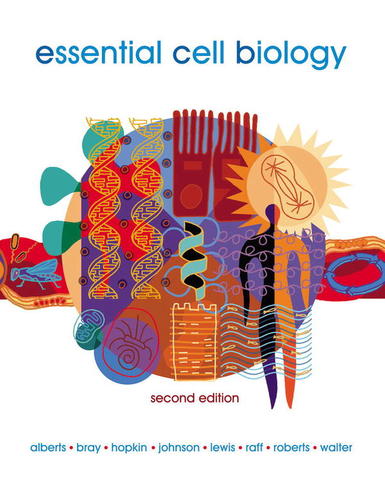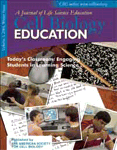An Essential Introductory Text

In many colleges and universities, including my own, the biology major encompasses the range of biological complexity from molecular and cellular biology through ecology and ecosystem biology. Biology majors often“ learn” molecular and cellular biology in a single-semester tour de force, usually a class taken during a student's freshmen or sophomore year in college. Although many students go on to more advanced courses in either cellular or molecular biology, this single class is the only exposure that many students have to one of the most rapidly growing fields in modern biology. The breadth of information that students need to master in a one-semester molecular/cellular biology course can be staggering, with topics including basic biochemistry, molecular biology, and foundational genetics, as well as classical cellular biology. Finding a textbook that adequately presents these broad areas at an appropriate introductory level is challenging. In fact, in the three years that I have taught the class, we have used three different textbooks. Our selection this past year was the second edition of Essential Cell Biology (ECB), and I expect that we will continue to use this book for years to come.
As an introductory text, the strength of ECB comes from its simplified, but not simplistic, treatment of the major topics in modern cellular and molecular biology. This edition of the book successfully incorporates the experimental aspects of cellular biology in a way that enhances understanding. In contrast to other introductory texts that often mix experimental findings with factual information, ECB segregates the experimental details from the instructional material. By organizing the text in this manner, students can first absorb the basic factual information without worrying about the nuances of experimental design and interpretation. In general, ECB provides a solid foundation in the fundamentals of basic cellular and molecular biology and, at the same time, introduces the beginning student to data acquisition, analysis, and interpretation. It is true however that the qualities that make ECB such a wonderful introductory text, perhaps entirely appropriate for first-year biology students, might not make it the right choice for students that are even a little more advanced. In my course, which is typically taken by sophomores, the student evaluations revealed that they felt that the text was too simple and didn't delve deeply enough into the complex material. Fortunately, however, there are a number of additional resources available, including a more advanced textbook, Molecular Biology of the Cell (MBoC), and a book of experiment-based problems, Molecular Biology of the Cell: A Problems Approach that can be used for additional teaching material. By incorporating aspects of these texts (e.g., by assigning additional readings from MBoC or including in-class problem-solving sessions), I think that ECB can be an integral component of even a sophomore-level introductory course.
FLOW AND AUDIENCE
By distilling the foundational concepts and methods of modern molecular and cellular biology, while making minimal assumptions about a student's previous background in biology, ECB serves introductory molecular and cellular biology students well. For those familiar with the previous edition of ECB, the new version is not simply an update, but rather an overhaul of the first edition. The second edition of ECB continues to focus on the molecular and cellular components of eukaryotic cells and describes how these components are integrated to form a functioning, living cell. Aside from the addition of new material on genetics and the reorganization of topics related to gene expression, the biggest change is that the new edition has a more experimental emphasis, which I discuss in more detail.
The text begins with descriptions of cell structure, moves through basic biochemistry and molecular genetics, and follows with chapters on more specialized topics, including membrane structure and function, bioenergetics, and the cytoskeleton. The final chapter on tissues and cancer enables students to apply much of the information they learned in previous chapters to understanding a health-related problem. The information in the text is up to date, including accurate descriptions of topics such as cloning and stem cell research and methods such as DNA microarray analysis.
All of the chapters are organized with the text delineated by major subject headings, and all the chapters culminate with a section titled“ Essential Concepts,” which very clearly enumerates the essential points from the reading. Additionally, the text also includes questions, some of which are interspersed in the chapters, and some found at the end of the chapters. These questions are thought provoking and require a considerable level of sophistication to answer. Because the answers to all of the questions are provided in the back of the book, it is not feasible to assign them as credited work, but I often encourage students to do these problems as a way to self-check their understanding of the material. They can also serve as jumping off points for classroom discussions or impromptu problem sets in class.
The figures and diagrams, like the text itself, are simple and uncluttered. Cartoon renditions of molecules are not simple blobs, but they are also not overly complicated in their representation. The artwork throughout the book has a uniform look, with common color palates and drawings. Although they are relatively simple, the figures are accurate and adequately labeled. Most importantly, the figures clearly demonstrate the processes that are described in the text and they translate particularly well to presentation in the classroom.
ESSENTIAL SUCCESS
For my students, ECB succeeds remarkably well in providing basic foundations without oversimplifying complex processes. A lovely example of this success is the discussion of cell cycle regulation in Chapter 18. In this chapter, students are introduced to the key molecules involved in cell cycle regulation, the cyclins and the cyclin-dependent kinases (cdks). The multiple cdks and multiple cyclins of mammalian cells are all introduced by name, ensuring that the overall complexity of the system is not lost on the reader. However, the text does not overwhelm the reader with complexity. For example, the details of cdk regulation by phosphorylation, including the particular amino acid residues that are modified and the names of the kinases and phosphatases that catalyze these modifications, are not mentioned. Instead, the process is presented in a more generalized manner by referring to“ inhibitory phosphate” or “stimulatory phosphate.” This example demonstrates the success of the text in choosing which specific details can be safely eliminated from the text without sacrificing content or clarity and without preventing students from realizing the important subtleties and nuances of a process. ECB provides a complete story, including both key concepts and essential details. As a result, students are not overwhelmed with information and are much more likely to remember the big ideas and understand the relevant details.
ESSENTIAL EXPERIMENTS
The success of ECB in providing a foundational understanding of molecular cell biology is enhanced by an experimental focus. Throughout the text, the authors emphasize the process of science and discovery by presenting relevant experimental results and interpretations. Whenever possible or appropriate, actual data are shown instead of cartoon renditions. Every chapter also contains a separate section titled “How We Know.” These two-page summaries describe landmark discoveries in cellular or molecular biology from a purely experimental standpoint. These sections provide a reflective point of view by describing the technical and experimental systems available at the time the discoveries were made and how the technical limitations affected experimental design and interpretation. In these sections, specific names and dates also give the reader a much-appreciated historical perspective. Emphasizing the history of science is something I often do in class, although I always assure students that I will not ask, “What major discovery did Marshall Nirenberg make?” I realize that learning about individual scientists and the details of a particular set of important experiments helps students understand that science is not a series of dry facts but is about discovering new, sometimes completely unexpected findings.
INSTRUCTOR MATERIALS
To assist instructors, ECB provides supplemental resources, including the Essential Cell Biology 2 Interactive CD-ROM (ECB2) with videos, animations, and molecular models. This resource is a veritable treasure trove of information and potential teaching material, with well over a hundred videos, animations, and additional figures. Also included, is a feature called “ECB2 Interactive,” which provides videos and animations with a narrated voice-over describing the action. These minimovies are also accompanied by an ECB2“ Viewing Guide” that gives a description of who provided the images or video clips and points out several questions about the image or video. As an instructor, these videos and animations can be helpful, but they can also be quite distracting in the classroom. Some processes, such as the movement of the cytoskeletal motor proteins kinesin and myosin, are much more easily understood when students can visualize the movements I try to describe. The animations provided in the CD were enormously helpful in this regard. However, many of the animations did not provide any additional help in getting students to see or understand concepts. A good example of this was an animation that described the removal of introns by splicing. While it was beautifully rendered, the animation did not illuminate the process any better than what I could do with colored chalk on the blackboard. By carefully perusing the rich selection of teaching material included with the textbook, it is possible to select videos and images that will enhance lectures without bombarding students with excessive high-tech distraction.
In addition to the resources specific to ECB, I find that the more advanced textbook by the same authors, MBoC, is an excellent resource for more in-depth coverage of topics that might be of particular interest. I often refer to this text when preparing lectures, and I frequently point students to this text if they have additional questions on specific topics. I also teach the Advanced Cell Biology course at my college, and MBoC is the required text for the upper-level course. MBoC is a sophisticated and comprehensive extension of ECB, and I anticipate that the familiar feel of the writing and design of MBoC will mean a smooth transition for those students who had ECB as their introductory text.
The accompanying book to MBoC, Molecular Biology of the Cell: A Problems Approach by John Wilson and Tim Hunt, contains problem sets and questions covering nearly all aspects of cellular and molecular biology. Although many of the questions are too sophisticated for exams in introductory classes, the experimental problems are wonderful learning tools for discussions in the classroom. In our introductory course, we have a weekly one-hour recitation section, and rather than spending that time simply reviewing the lecture material, we assign one or two of the particularly challenging experimental questions from the MBoC problems book. Students work together to analyze and interpret the data and this peer learning has proven very successful in helping students become engaged with the material in a fun yet demanding way.
THE BOTTOM LINE
ECB is a textbook that delivers what it promises: the essential facts of modern cellular and molecular biology in a digestible and memorable form. On its own, ECB is a great introductory text appropriate for beginning biology majors or for others interested in cell biology. By combining it with additional material, ECB can also serve slightly more advanced beginning students. Although ECB itself is not a text that students can hold onto and grow with as they move through their biology education, it can serve as a succinct and accurate introduction to cell and molecular biology. For those who move on to more advanced courses in college or to the graduate level, the MBoC text provides a much more advanced continuation from ECB. Ultimately, the strength of ECB is that it is the foundation in a series of materials and resources that collectively help students forge a deep understanding of cell biology.



